|
|
Back to Blog
TOP FOODS FOR LUNG HEALTH6/25/2013  EAT THESE! These foods are high in vitamins, minerals and biochemicals that are beneficial to the lungs. 1. Apples 2. Apricots 3. Beans: Black and Kidney 4. Berries 5. Broccoli 6. Salmon and other fatty fish 7. Poultry 8. Walnuts Don't forget to drink lots of water!
0 Comments
Read More
Back to Blog
 You've already got your N95 face mask, the air purifiers and are not doing excessive outdoor activity. Here are more protective measures against lung damage and disease to work into your regular routine. 1. Don't ignore your snore. If snoring is a chronic problem, you are likely to be damaging your lungs as much as haze and smoking. Make an appointment to clear your airways. The doctor may prescribe a better pillow or surgery at worst. 2. Practice more aerobic activity. One hour a day of minor puffing broken up over 4 sessions has been shown to improve breathing in emphysema patients. 3. Consume more Omega-3 supplements. This fish oil supplement is an all-round anti-inflammatory. 4. Strengthen your Abs. Your abs and chest muscles help you to breathe. Work in 10-20 crunches a day to reduce lung burden. Also practicing deep abdominal breathing will help reduce muscular activity in the lungs.
Back to Blog
IS YOUR SKINCARE HARMING YOU?6/25/2013 If you always suspected that something was wrong with all those chemicals on that ingredient list at the back of your cleanser, moisturiser or shampoo. You were right. And don't even imagine that the government has you covered.
Think twice the next time you pick up your skincare. Most of Asia imports mainstream and popular cosmetic brands from the US and Europe, and most of these brands are not as regulated by the Food and Drug Administration as you would imagine. Here are some common myths on cosmetic safety for your attention, courtesy of the Environmental Working Group, a US non-profit dedicated to cosmetic safety. Myth – If it’s for sale at a supermarket, drugstore, or department store cosmetics counter, it must be safe. Fact – The Food and Drug Administration (FDA) has no authority to require companies to test products for safety. FDA does not review or approve the vast majority of products or ingredients before they go on the market. The agency conducts pre-market reviews only for certain color additives and active ingredients in cosmetics classified as over-the-counter drugs (FDA 2005, 2010). Myth – The cosmetics industry effectively polices itself, making sure all ingredients meet a strict standard of safety. Fact – In its more than 30-year history, the industry’s safety panel (the Cosmetic Ingredient Review, or CIR) has assessed fewer than 20 percent of cosmetics ingredients and found only 11 ingredients or chemical groups to be unsafe (FDA 2007, CIR 2009, Houlihan 2008). Its recommendations are not binding on companies (Houlihan 2008). Myth – The government prohibits dangerous chemicals in personal care products, and companies wouldn’t risk using them. Fact – Cosmetics companies may use any ingredient or raw material, except for color additives and a few prohibited substances, without government review or approval (FDA 2005, FDA 2000).
Fact – People are exposed by breathing in sprays and powders, swallowing chemicals on the lips or hands or absorbing them through the skin. Studies find evidence of health risks. Biomonitoring studies have found cosmetics ingredients – like phthalate plasticizers, paraben preservatives, the pesticide triclosan, synthetic musks, and sunscreens – as common pollutants in men, women and children. Many of these chemicals are potential hormone disruptors (Gray et al. 1986, Schreurs et al. 2004, Gomez et al. 2005, Veldhoen et al. 2006). Products commonly contain penetration enhancers to drive ingredients deeper into the skin. Studies find health problems in people exposed to common fragrance and sunscreen ingredients, including elevated risk for sperm damage, feminization of the male reproductive system, and low birth weight in girls (Duty et al. 2003, Hauser et al. 2007, Swan et al. 2005, Wolff et al. 2008). Myth – Products made for children or bearing claims like “hypoallergenic” are safer choices. Fact – Most cosmetic marketing claims are unregulated, and companies are rarely if ever required to back them up, even for children’s products. A company can use a claim like “hypoallergenic” or “natural” “to mean anything or nothing at all,” and while “[m]ost of the terms have considerable market value in promoting cosmetic products to consumers,… dermatologists say they have very little medical meaning” (FDA 1998). An investigation of more than 1,700 children’s body care products found that 81 percent of those marked “gentle” or “hypoallergenic” contained allergens or skin and eye irritants (EWG 2007a). Myth – Natural and organic products are always safer. Fact – Products labeled natural or organic often contain synthetic chemicals, and even truly natural or organic ingredients are not necessarily risk-free. The global, plant-based pharmaceutical market, valued at $19.5 billion in 2008, relies on the ability of “natural” chemicals – like those used in some natural cosmetics – to significantly alter body functions, a far cry from innocuous (BCC Research 2006, 2009). On the other hand, products labeled “organic” or “natural” can contain petrochemicals and no certified organic or natural ingredients whatsoever. Products certified as organic can contain as little as 10% organic ingredients by weight or volume (Certech 2008). FDA tried establishing an official definition for the term “natural,” but these protections were overturned in court (FDA 1998). Research shows that 35 percent of children’s products marketed as “natural” contain artificial preservatives (EWG 2007a). Myth – FDA would promptly recall any product that injures people. Fact – FDA has no authority to require recalls of harmful cosmetics. Furthermore, manufacturers are not required to report cosmetics-related injuries to the agency. FDA relies on companies to report injuries voluntarily (FDA 2005). Myth – Consumers can read ingredient labels and avoid products with hazardous chemicals. Fact – Federal law allows companies to leave many chemicals off labels, including nanomaterials, ingredients considered trade secrets, and components of fragrance (Houlihan 2008). Fragrance may include any of 3,163 different chemicals (IFRA 2010), none of which are required to be listed on labels. Fragrance tests reveal an average of 14 hidden compounds per formulation, including potential hormone disruptors and diethyl phthalate, a compound linked to sperm damage (EWG & CSC, 2010). Conclusion There is yet to be significant change in consumer expenditure patterns although the market share of natural cosmetics is slowly but steadily rising. In this day and age where results matter more than safety, it is still wise to be aware of the potential long term risks, so that we are better able to manage our health. Here is a list of ingredients to watch out for. ------------------------------------------------------------------------------------------------------ The EWG (www.ewg.org) maintains a phenomenally useful database on 65,000 products and/or ingredients present in our cosmetics today. Use their scores to gauge relative safety of your products, and read the research on functions, hazards and cancer risks. References BCC Research. 2006. Plant-Derived Drugs: Products, Technolog, Applications. Report Code BIO022D. June 2006. http://www.bccresearch.com/report/BIO022D.html. BCC Research. 2009. Safety Botanical and Plant-Derived Drugs: Global Markets. Report Code BIO022E, February 2009. http://www.bccresearch.com/report/BIO022E.html. Calafat AM, Wong LY, Ye X, Reidy JA, Needham LL. 2008. Concentrations of the sunscreen agent benzophenone-3 in residents of the United States: National Health and Nutrition Examination Survey 2003–2004. Environ Health Perspect. 2008 Jul;116(7):893-7. Certech Registration Inc. 2008. International organic standard – Natural and natural organic cosmetic certification. IOS Cosmetics. Issue 01. April 2008. http://www.certechregistration.com/IOS_cosmetics_standard.pdf. CIR (Cosmetic Ingredient Review). 2009. Ingredients found unsafe for use in cosmetics (9 total, through December, 2009). http://www.cir-safety.org/findings.shtml. CSC (Campaign for Safe Cosmetics). 2007. Lead in lipstick. http://www.safecosmetics.org/article.php?id=223. CSC (The Campaign for Safe Cosmetics). 2009. No more toxic tub. http://www.safecosmetics.org/downloads/NoMoreToxicTub_Mar09Report.pdf. Duty SM, Singh NP, Silva MJ, Barr DB, Brock JW, Ryan L, et al. 2003. The Relationship between Environmental Exposures to Phthalates and DNA Damage in Human Sperm Using the Neutral Comet Assay. Environ Health Perspect 111(9): 1164-9. EWG (Environmental Working Group). 2004. Exposures Add Up – Survey Results. http://www.ewg.org/skindeep/research/exposures.php. EWG (Environmental Working Group). 2006. EWG Comments to FDA on Nano-Scale Ingredients in Cosmetics. Docket: FDA Regulated Products Containing Nanotechnology Materials. Docket number: 2006N-0107. http://www.ewg.org/node/21738. EWG (Environmental Working Group). 2007a. Safety Guide to Children’s Personal Care Products. http://www.ewg.org/skindeep/special/parentsguide/summary.php. EWG (Environmental Working Group). 2007b. Cosmetics with banned and unsafe ingredients. Table 1 – Banned in other countries. Accessed June 21, 2010. http://www.ewg.org/node/22624. EWG (Environmental Working Group). 2007c. Cosmetics With Banned and Unsafe Ingredients. Table 2 – Unsafe for use in cosmetics, according to industry. Accessed June 21, 2010. http://www.ewg.org/node/22636. EWG (Environmental Working Group). 2007d. EWG research shows 22 percent of cosmetics may be contaminated with cancer-causing impurity. http://www.ewg.org/node/21286. EWG (Environmental Working Group). 2010. EWG’s 2010 sunscreen guide. Nanomaterials and hormone disruptors in sunscreens. http://www.ewg.org/2010sunscreen/full-report/nanomaterials-and-hormone-disruptors-in-sunscreens/. EWG & CSC (Environmental Working Group and Campaign for Safe Cosmetics). 2010. Not so sexy. Hidden chemicals in perfume and cologne. http://www.safecosmetics.org/article.php?id=644 FDA (U.S. Food and Drug Administration). 1998. Clearing Up Cosmetic Confusion” by Carol Lewis. FDA Consumer magazine. May-June 1998. http://www.pueblo.gsa.gov/cic_text/health/cosmetic-confusion/398_cosm.html. FDA (U.S. Food and Drug Administration). 2000. Ingredients prohibited & restricted by FDA regulations. June 22, 1996; Updated May 30, 2000. http://www.fda.gov/Cosmetics/ProductandIngredientSafety/SelectedCosmeticIngredients/ucm127406.htm. FDA (U.S. Food and Drug Administration). 2005. FDA authority over cosmetics. http://www.cfsan.fda.gov/~dms/cos-206.html. FDA (U.S. Food and Drug Administration). 2007. Compliance Program Guidance Manual. Program 7329.001. Chapter 29 – Colors and Cosmetics Technology. http://www.fda.gov/downloads/cosmetics/GuidanceComplianceRegulatoryInformation/ComplianceEnforcement/ucm073356.pdf. FDA (U.S. Food and Drug Administration). 2010. Regulation of non-prescription products. http://www.cfsan.fda.gov/~dms/cos-206.html. Gomez E, Pillon A, Fenet H, Rosain D, Duchesne MJ, Nicolas JC, et al. 2005. Estrogenic activity of cosmetic components in reporter cell lines: parabens, UV screens, and musks. Journal of toxicology and environmental health 68(4): 239-251. Gray TJ, Gangolli SD. 1986. Aspects of the testicular toxicity of phthalate esters. Environmental health perspectives 65: 229-23. Hauser R, et al. DNA damage in human sperm is related to urinary levels of phthalate monoester and oxidative metabolites. Hum Reprod. 2007;22(3):688-95. Houlihan, J. 2008. Statement of Jane Houlihan on Cosmetics Safety: Discussion Draft of the ‘Food and Drug Administration Globalization Act’ Legislation: Device and Cosmetic Safety. Before the Subcommittee on Health of the Committee on Energy and Commerce, United State House of Representatives. May 14 2008. http://www.ewg.org/node/26545. IFRA (International Fragrance Association). 2010. Ingredients. IFRA survey: Transparency list. http://www.ifraorg.org/public/index_ps/parentid/1/childid/15/leafid/111. Schreurs RH, Legler J, Artola-Garicano E, Sinnige TL, Lanser PH, Seinen W, et al. 2004. In vitro and in vivo antiestrogenic effects of polycyclic musks in zebrafish. Environmental science & technology 38(4): 997-1002. Swan SH, Main KM, Liu F, Stewart SL, Kruse RL, Calafat AM, et al. 2005. Decrease in anogenital distance among male infants with prenatal phthalate exposure. Environ Health Perspect 113(8):1056-61. Veldhoen N, Skirrow RC, Osachoff H, Wigmore H, Clapson DJ, Gunderson MP, et al. 2006. The bactericidal agent triclosan modulates thyroid hormone-associated gene expression and disrupts postembryonic anuran development. Aquatic toxicology (Amsterdam, Netherlands) 80(3): 217-227. Wolff MS, Engel SM, Berkowitz GS, Ye X, Silva MJ, Zhu C, Wetmur J, Calafat AM. 2008. Prenatal phenol and phthalate exposures and birth outcomes. Environ Health Perspect. 2008 Aug;116(8):1092-7.
Back to Blog
COSMETICS' BIG BAD WOLVES6/25/2013 |




